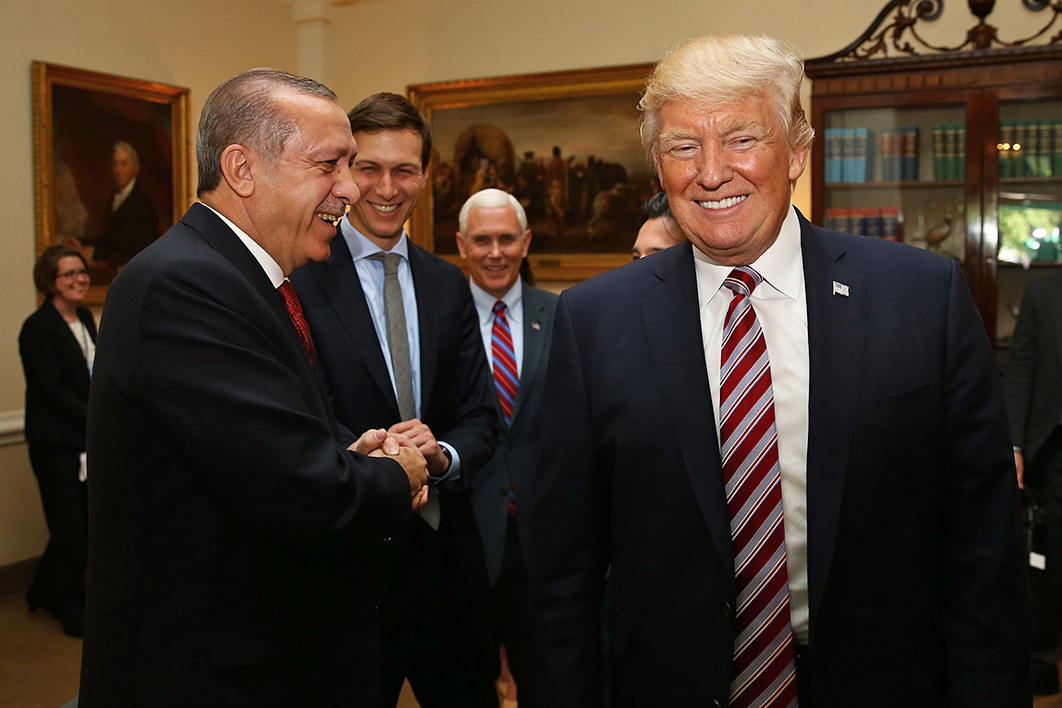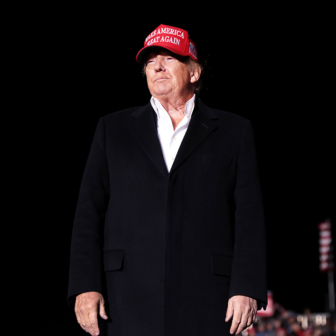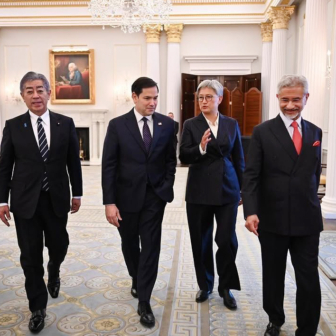Sometimes you have to sit up straight and look the facts in the face. Yes, Donald Trump is the president of the United States of America. Time might slowly dull this realisation, but it shouldn’t. We’ve witnessed bad presidents before — and perhaps, when all is calculated, more destructive ones — but none this shameless. From his opening campaign speech, in which he described immigrants as rapists and drug dealers, Trump revelled in ignorance, flaunting his indifference to truth and contempt for the complexities of government. He spread racist conspiracy theories and threatened to jail his opponent. This was a man without even the pretence of depth, a vindictive and easily distracted bully, proudly incurious about the world outside his own experience.
And yet with all this knowledge — he never attempted to hide any of it — the American people still chose him as their leader. I watched the count at a Democrats Abroad event in Canberra, and I’ve never seen a room change so quickly. Early confidence turned into mild panic, which then turned into open devastation, all within an hour. People were crying. If this was democracy, something was very sick in its heart.
Trump’s election was not the first sign of modern democratic malaise, nor necessarily the most extreme. Well before his triumph, academics observed a concerning “plateau” in global democracy, as the “third wave” of democratic expansion stalled, and in some places even went backwards. Trump’s success did, however, shock advanced democracies into attention. They could no longer ignore the trend — dismissing it as an affliction of lesser countries — or assume themselves immune to its authoritarian temptations. For the first time in a long time, they were forced to consider the unthinkable: could it happen to us?
Over the past year, a growing pile of books have dedicated themselves to answering this question. The titles give a sense of their morbid tone (How Democracies Die, How Democracy Ends, The Death of Democracy). While the books approach the topic from different directions — comparing contemporary cases of democratic failure, retelling the story of fascism in the 1930s, examining the modern system’s internal health — each takes the threat seriously. As they all acknowledge, democracy is a development in the history of politics, neither natural nor inevitable. It possesses vulnerabilities, at least under the right conditions.
In How Democracies Die: What History Reveals About Our Future, two Harvard political scientists, Steven Levitsky and Daniel Ziblatt, examine recent examples of democratic collapse. The authors are well aware of the system’s fragility, having spent their careers researching authoritarian revival across multiple continents. Their book compares some of the most prominent cases — Venezuela under Chávez, Turkey under Erdoğan, Hungary under Orbán — in search of the common “warning signs” preceding democratic decline. For the authors, this exercise carries an urgent political mission: “History doesn’t repeat itself, but it rhymes. The promise of history, and the hope of this book, is that we can find the rhymes before it’s too late.”
Levitsky and Ziblatt’s basic argument is that democracy is less dependent on formal rules than on its guiding spirit. Constitutions might be necessary pieces of paper, even sources of national pride, but they only work properly when reinforced by norms and limited by taboos. Levitsky and Ziblatt call these the “guardrails of democracy.” Although largely unspoken, two in particular are important: “mutual toleration” (parties must view each other as more or less legitimate, not as an existential threat to society) and “institutional forbearance” (parties must allow government to function in some agreed-on way, not seek every possible mechanism to destroy their political enemies).
Democracy, at least from this perspective, is threatened when one side stops obeying the implicit rules of participation. Politics then becomes the continuation of civil war by other means. This is more likely in certain contexts, and particularly in deeply unequal and polarised ones: “When societies grow so divided that parties become wedded to incompatible worldviews, and especially when their members are so socially segregated that they rarely interact, stable partisan rivalries eventually give way to perceptions of mutual threat.” This encourages the aspiring authoritarian, who promises to save one tribe from society’s other, fundamentally alien half.
The most dramatic example of this democratic breakdown — and the one that still haunts our political imagination — is Adolf Hitler’s destruction of Weimar Germany in the 1930s. This can be difficult to talk about, particularly in the context of contemporary democracy: it feels wrong to compare Nazism to other regimes as if the lessons of evil could apply to our more ambiguous political lives. In The Death of Democracy: Hitler’s Rise to Power, political historian Benjamin Carter Hett attempts this delicate task, tracking German politics from the trauma of the first world war and then the relative peace of the late 1920s, to the burning Reichstag building and the Enabling Act that opened the way to dictatorship. It’s a tale that can only be cautionary. We already know the terrible ending.
The collapse of Weimar Germany was a long process that ended very quickly. On one level, German society in 1933 was still split along the same lines as in 1918, between the myth of glorious national unity and the reality of military collapse. These history wars divided the country into political, economic and geographic camps. Financial crisis brought these latent differences to the surface, as did the crushing unemployment that followed. Here the book echoes Levitsky and Ziblatt: “For a democracy to work, all parties have to acknowledge that they have at least some minimal common ground and that compromises are both possible and necessary. By the 1930s, however, there was very little of this spirit left as German society grew ever more bitterly divided.”
From his earliest political interventions, Hitler openly expressed his opposition to Weimar democracy. Nazis never accepted the legitimacy of their political enemies, viciously targeting Jewish citizens and even attempting an armed coup in 1923. But for all its menace and the noise it made, hardline fascism was never popular enough to win power on its own. Hitler’s rise required the submission of other political figures who were well aware of his autocratic instincts. For establishment conservatives, the only alternative was governing alongside the Social Democrats — something that the aristocratic president, Paul von Hindenburg, opposed on principle. It was during this parliamentary stalemate in 1933 that Hindenburg agreed to make Hitler chancellor. He and other establishment figures thought they could keep the rabid dog on a tight leash. As Franz von Papen, Hitler’s vice-chancellor, boasted afterwards, “In a few months we will have pushed him so far into the corner that he will squeak.”
Levitsky and Ziblatt describe this as the “importance of fateful alliances” in democratic failure, and its message for modern politicians is clear enough. Other lessons from Hitler’s rise are less obviously applicable to the modern moment. For one, politics in 1930s Germany existed within a largely forgotten culture of political violence. It’s difficult to imagine now, but parties possessed their own paramilitary fighting wings, which clashed frequently and fatally. The Nazis employed theirs with a brutal logic. When the Reichstag burned down in February 1933, they immediately rounded up Communists and tortured them. When parliament debated the Enabling Act in March, Nazi stormtroopers surrounded the building, leering at the entering politicians. Hitler then murdered his remaining conservative rivals.
For those living in Weimar Germany, there was little doubt that democracy had been replaced with something else. (By November 1933, National Socialists were the only politicians legally able to stand for election.) This is another point where contemporary democracies diverge from the first age of fascism. Modern autocrats generally avoid clarifying moments of change. Their rise tends to be incremental; the exact moment of democratic death is difficult to diagnose. As the American political scientist Nancy Bermeo puts it, modern democracies are more likely to “backslide” until eventually they are unrecognisable. “Elected executives weaken checks on executive power one by one,” she writes, “undertaking a series of institutional changes that hamper the power of opposition forces to challenge executive preferences.”
In some ways, the overwhelming horror of Hitler’s rise limits our understanding of contemporary authoritarianism. Unlike Germany in early 1933, modern democracies rarely explode in a single event. In developed countries at least, the military coup is largely a relic of politics past, as is the armed revolution. These dramatic gambles either rose or fell in a matter of hours; democratic backsliding can take years. As Levitsky and Ziblatt write, “Because these measures are carried out piecemeal and with the appearance of legality, the drift into authoritarianism doesn’t always set off alarm bells. Citizens are often slow to realise that their democracy is being dismantled — even as it happens before their eyes.”
When democracy is threatened in 2018, it is more likely to resemble Viktor Orbán’s government in Hungary. Orbán combines genuine public support with pointed attacks on pluralist institutions. In 2010, his Fidesz party won a supermajority in parliament — which it then used to rewrite political rules in its favour. Previously impartial organisations now reinforce government interests. Gradually, Orbán ended state media independence, stacked autonomous bodies with loyalists, undermined opposition parties with heavy fines, and changed electoral laws to make parliament even more majoritarian. For all this, Orbán remains extremely popular, according to the available polling.
As David Runciman observes in How Democracy Ends, figures like Orbán are deeply paradoxical: popularly elected leaders who nonetheless use democracy’s legitimacy to justify its deconstruction. Is Orbán an autocrat? It depends whom you ask. Because of this ambiguity, those who think so can themselves be accused of conspiracy theory: “While the opponents of the regime shout, ‘Coup!,’ its defenders say that those accusations are hyperbole and hysteria. Lawyers and journalists who see themselves as the last line of defence against the subversion of democracy can be recast by the other side as just another group of ‘special interests,’ claiming the benefits of democracy for themselves.”
The modern autocrat accumulates power with more subtlety than the twentieth-century dictator, and is usually less openly combative towards democracy. This makes the whole process difficult to think about, let alone discuss in a common civic language. Compounding this, politicians often use democratic tools for undemocratic ends. When Recep Tayyip Erdoğan sought to expand the powers of the Turkish presidency — and undermine legislative checks on his office — he did so by popular referendum. While the credibility of the process itself was challenged by Erdoğan’s opponents, the exercise raised another confusing paradox: what happens when a democracy chooses to vote itself out of existence?
Some of this, Runciman argues, is democracy’s own fault (“Democracy is not working well — if it were, there would be no populist backlash”). He compares its condition to a midlife crisis. It’s a slightly laboured analogy, but the image captures something of the moment’s sense of exhaustion, the pervasive feeling of dissatisfaction, and the desire of many citizens to take political risks. Part of this reflects democracy’s inability to grapple with genuine, perhaps existential, crises, like climate change. Next to more rigid and disciplined regimes, modern democracies can feel myopic, incapable of looking beyond the present. Part of the problem, however, is built into the system itself. As Runciman often puts it, democracies tend to “muddle through” their problems, generally coming to an acceptable solution, albeit often by accident. “The process is not pretty, and it creates a widespread feeling of disappointment.”
Runciman has covered similar ground before, particularly in The Confidence Trap: A History of Democracy in Crisis from World War I to the Present (2013). As might be clear, he delights in paradox and contradiction, moments when the essence of a situation is different from what appears on its surface. If autocrats are on the global march, the news isn’t all bad, at least in the long run. While democracies face an urgent challenge to make politics feel “real” again to citizens — and not simply a spectacle performed at a professional distance — they possess hidden strengths, not necessarily shared by authoritarian equivalents.
According to Runciman, the same factors that make democracies drift are the ones that make them survive (“the flexibility, the variety, the responsiveness”). The reverse is also true. The factors that make autocracies look strong in the short term — the decisiveness, the unity of purpose, the lack of institutional accountability — are those that let them avoid their most complex problems, often until it’s too late. If democracies erode, then autocracies tend to shatter. This was the essential pattern of twentieth-century politics; we are yet to see if it will be repeated in the twenty-first. •




